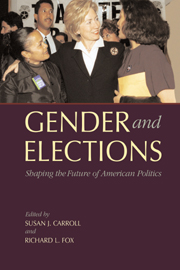Book contents
- Frontmatter
- Contents
- List of Figures, Text Boxes, and Photo
- List of Tables
- Acknowledgments
- List of Contributors
- Introduction: Gender and Electoral Politics into the Twenty-First Century
- 1 Presidential Elections
- 2 Voter Participation and Turnout
- 3 Voting Choices
- 4 Congressional Elections
- 5 African American Women and Electoral Politics
- 6 Political Parties and Women's Organizations
- 7 Advertising, Web Sites, and Media Coverage
- 8 State Elections
- Index
7 - Advertising, Web Sites, and Media Coverage
Gender and Communication Along the Campaign Trail
Published online by Cambridge University Press: 05 June 2012
- Frontmatter
- Contents
- List of Figures, Text Boxes, and Photo
- List of Tables
- Acknowledgments
- List of Contributors
- Introduction: Gender and Electoral Politics into the Twenty-First Century
- 1 Presidential Elections
- 2 Voter Participation and Turnout
- 3 Voting Choices
- 4 Congressional Elections
- 5 African American Women and Electoral Politics
- 6 Political Parties and Women's Organizations
- 7 Advertising, Web Sites, and Media Coverage
- 8 State Elections
- Index
Summary
U.S. Senator Patty Murray (D-WA), one of five women elected to the U.S. Senate in 1992's so-called “Year of the Woman,” entered the 2004 campaign on the verge of making history. If she won re-election, she would be the first senator from Washington state to earn a third consecutive term since the late Henry “Scoop” Jackson.
In 1992, Murray had made a name for herself campaigning – in her televised political ads, news releases, and speeches – as the proverbial “mom in tennis shoes,” referring to a remark made by a male state legislator in the early 1980s when she was lobbying against budget cuts to a preschool program where she taught. Told by the legislator that she could not make a difference because she was “just a mom in tennis shoes,” Murray went on to organize 13,000 parents to save the preschool program, serve on her local school board and then in the Washington State Senate, and win election to the U.S. Senate in 1992 against a powerful Republican congressman.
While her “mom in tennis shoes” persona remained intact in 2004, Murray exhibited her political savvy in her re-election campaign, defeating Republican Congressman George Nethercutt, who was strongly backed by President Bush, by more than 345,000 votes and raising twice as much money as her opponent.
Murray's 2004 re-election campaign is an example of how a political candidate's communication – both through televised political spots and a web site – as well as media coverage can come together to create a positive, integrated message that connects with voters.
- Type
- Chapter
- Information
- Gender and ElectionsShaping the Future of American Politics, pp. 169 - 188Publisher: Cambridge University PressPrint publication year: 2005
- 4
- Cited by



